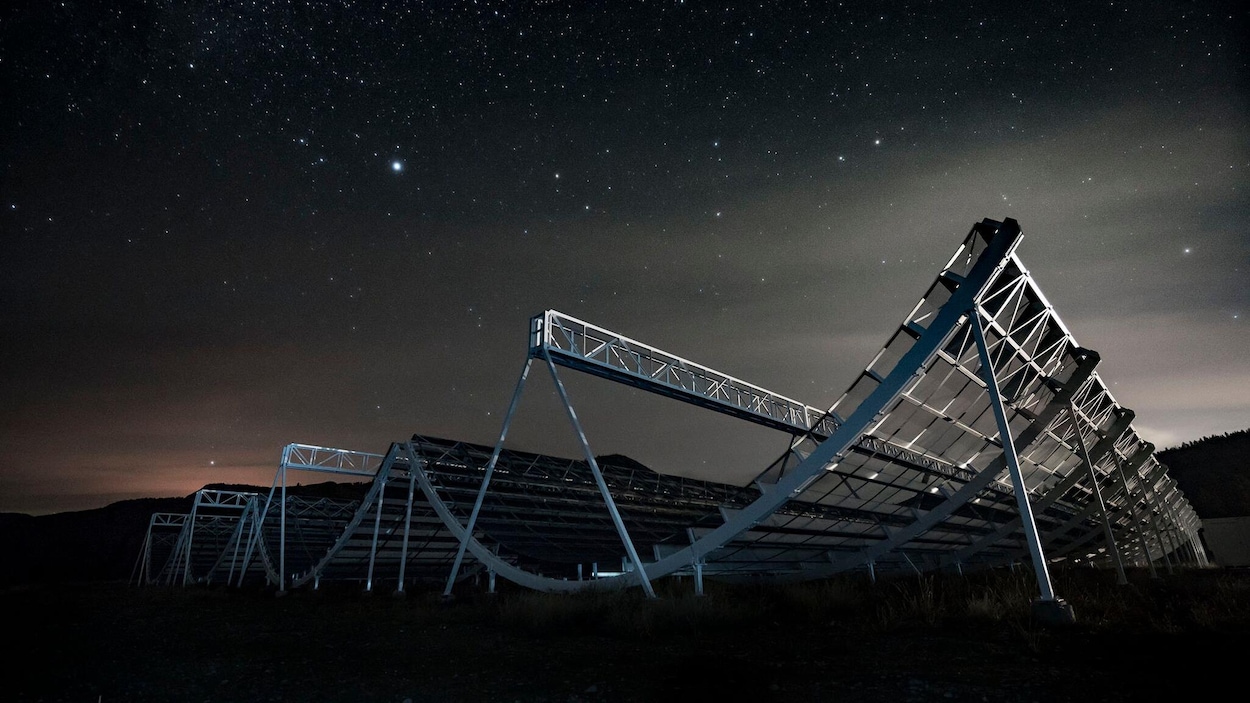Unexpected discovery: fast radio bursts detected in an ancient galaxy 💥
Follow us on Google News (click on ☆)
FRBs, these mysterious flashes of radio waves, have long been considered products of young and active galaxies. However, an international team recently located an FRB in an elliptical galaxy aged 11.3 billion years, located 2 billion light-years from Earth. This discovery, published in The Astrophysical Journal Letters, suggests that the origins of FRBs could be more varied than expected.

The CHIME radio telescope consists of four U-shaped cylinders, each 100 meters long, made of a metal lattice. CHIME reconstructs the image of the sky by processing radio signals captured by over a thousand antennas.
Source: CHIME
Researchers used the CHIME telescope to detect this FRB, named FRB 20240209A, which emitted 21 pulses between February and July 2024. The use of additional telescopes allowed for precise localization of the origin of these pulses, revealing a host galaxy of exceptional luminosity and mass.
Contrary to expectations, this FRB does not originate from a star-forming region, but from the outskirts of its host galaxy, 130,000 light-years from the center. This unusual location raises questions about the energetic mechanisms capable of producing FRBs in environments devoid of young stars.
This discovery recalls another FRB detected in 2022 in the globular cluster of galaxy M81, suggesting that these events might share similar origins. Researchers now hypothesize that some FRBs could originate from magnetars formed by alternative mechanisms, such as the merger of neutron stars or the collapse of white dwarfs.
To explore this hypothesis further, additional observations with the James Webb Space Telescope are planned. These studies could reveal the presence of a globular cluster at the origin of FRB 20240209A, offering new perspectives on the environments conducive to these cosmic phenomena.
FRBs continue to be a subject of fascination for astronomers due to their enigmatic nature and their ability to challenge our knowledge of the Universe. Each discovery opens new avenues of research, enriching our understanding of the most extreme cosmic mechanisms.
What is a fast radio burst (FRB)?
Fast radio bursts (FRBs) are intense emissions of radio waves that last a few milliseconds. They release in an instant more energy than the Sun does in a year.
First discovered in 2007, FRBs remain largely mysterious. Their exact origin is still unknown, although several theories have been proposed, including magnetars or collisions of neutron stars.
The detection of FRBs in ancient galaxies, as recently observed, challenges the idea that they originate exclusively from young stars. This suggests that FRBs could have multiple origins, involving various cosmic environments.
Why are FRBs in ancient galaxies surprising?
FRBs have traditionally been associated with young and active galaxies, where star formation is intense. These environments are conducive to the creation of magnetars, often considered the likely sources of FRBs.
The discovery of FRBs in ancient galaxies, where star formation ceased long ago, is therefore unexpected. This implies that FRBs could be produced by different mechanisms, such as the merger of neutron stars or the collapse of white dwarfs.
This discovery opens new perspectives on the diversity of cosmic environments capable of generating FRBs, enriching our understanding of these enigmatic phenomena.